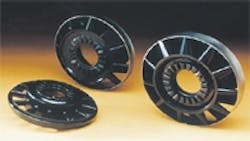Plastic composites take to the road
Most electric motor engineers know that phenolic composite materials offer excellent electrical insulation in commutators and brush holders. Less well known, however, is that molded phenolic components also replace metal assemblies in a variety of automotive applications.
These applications suggest other opportunities to use plastic industrial drive components, especially those produced in highvolume. Some examples of phenolic composite parts include transmission reactors, brake pistons, pulleys, and sprockets.
Molded phenolic composites offer several advantages over metals, including smooth surfaces, uniform density, weight reduction, and ability to damp vibration. These fiber-reinforced plastics handle applications that demand stiffness, chemical resistance, and dimensional stability at temperatures from 120 to 200 C. Particularly in high temperature stiffness and creep resistance, they outperform other plastic composites. Designers can tailor their properties to the needs of particular applications by adjusting the amounts of resin, fibers, fillers, and other additives.
Here are some application examples, which may stimulate other PT application ideas for plastic materials.
Electrical insulation
In motors, molded phenolic material holds the commutator on the motor shaft. In addition to holding the copper bars in place, the material provides electrical insulation between adjacent copper bars and between the bars and the shaft. Applications include automotive starter motors as well as automotive auxiliary, appliance, and industrial motors.
The dimensional stability of phenolic materials enables the commutators to remain virtually stable at spin speeds of 25,000 to 50,000 rpm, operating temperatures of 150 to 250 C, and soldering temperatures of 400 C for up to 30 sec. Because the commutator resists creep, bar movement is held to less than 0.0002 in.
These materials also encapsulate electrical and electronic components, providing electrical insulation along with strength. For example, the molded component in an automotive fuel injector can withstand 1,400 psi spikes for millions of cycles without excessive degradation or creep.
Corrosion resistance
Environments where water causes corrosion result in other applications for these materials. For example, a Japanese heavy-equipment manufacturer uses a corrosion-resistant, glass-reinforced phenolic water pump impeller that is molded to net shape. A boat manufacturer uses a bracket made of similar material in a tilt mechanism. This bracket resists corrosion, electrically insulates the brush holders, eliminates machining, and does not require a bearing as do metal brackets.
Metal replacement
Plastic materials, including phenolics, have replaced metal components in various automotive applications. The driving force in these high-volume applications is lower cost.
Plastics save money mainly through production process advantages. Injection molded fiber-reinforced plastic composites produce complex shapes with smooth and precise surfaces, thereby reducing finishing costs associated with metal. In addition, metal components consisting of several metal parts are often replaced by a single molded plastic component, reducing machining and assembly costs.
Replacing metal with plastic reduces weight, and enhances performance characteristics such as chemical and corrosion resistance, thermal insulation, and vibration and sound damping.
Automotive applications in which phenolic composites have replaced metal parts include torque converter reactors (also called stators), as well as other engine, transmission, and brake components.
Torque converter reactors. In the U.S. and Japan, glass-reinforced phenolics are used in reactors that direct transmission fluid within torque converters. These reactors are molded to net shape. Selecting phenolics rather than aluminum results in 20% weight reduction; elimination of crimping and other machine steps; part integration (some reactors incorporate an integral thrust washer); and reduced manufacturing costs.
Continue on page 2
Some thrust washers are formed separately from reactors, replacing needle bearing assemblies. Where glass-reinforced phenolic is used to mold these separate thrust washers, the material retains its strength and dimensional stability, and provides the wear resistance required in a high temperature transmission environment.
A typical molded reactor reduces the number of components from ten to three, combining seven of the original parts. In one case, a single molded phenolic component replaced five metal parts. The uniform density of these molded parts, combined with smooth vane surfaces, eliminates the need for dynamic balancing and reduces performance variations.
The composite molded parts used in these reactors also require less machining than those in cast aluminum reactors. Their dimensional accuracy is said to be an order of magnitude more precise than sand casting, and significantly more precise than die casting.
Other engine, transmission, and brake components. These components must withstand the same loads as their metal counterparts at temperatures of 120 to 200 C. For such operating conditions, glass-fiber-reinforced phenolics offer advantages over other plastic composites in several areas: cost, dimensional stability, retention of strength and modulus at high temperature, thermal expansion, and chemical resistance to fuel, methanol, and glycol. Most important, however, they offer excellent creep resistance at high temperature.
Designing plastic replacements
Replacing metal components and assemblies requires more than just substituting plastic materials into existing designs. When a plastic composite part replaces a joined metal part, for example, it’s usually necessary to make the load-bearing sections thicker, increase boss sizes, and round off edges to reduce stress concentrations. In addition to calculating strength of the new component, the designer needs to calculate dimensional changes in response to loads and temperature variations.
Designing plastic components also requires accurate information on the material properties. ASTM standard property values listed on suppliers’ data sheets are useful for initial material comparisons, but have limited usefulness in part design. Composite properties depend largely on processing conditions, and local properties within parts usually vary significantly from the ASTM values. Therefore, it’s important to understand the effects of process-induced fiber orientation and heat history on material properties.
William R. Ayles is the marketing supervisor for Rogers Corp., Molding Materials Div., Manchester, Conn.
